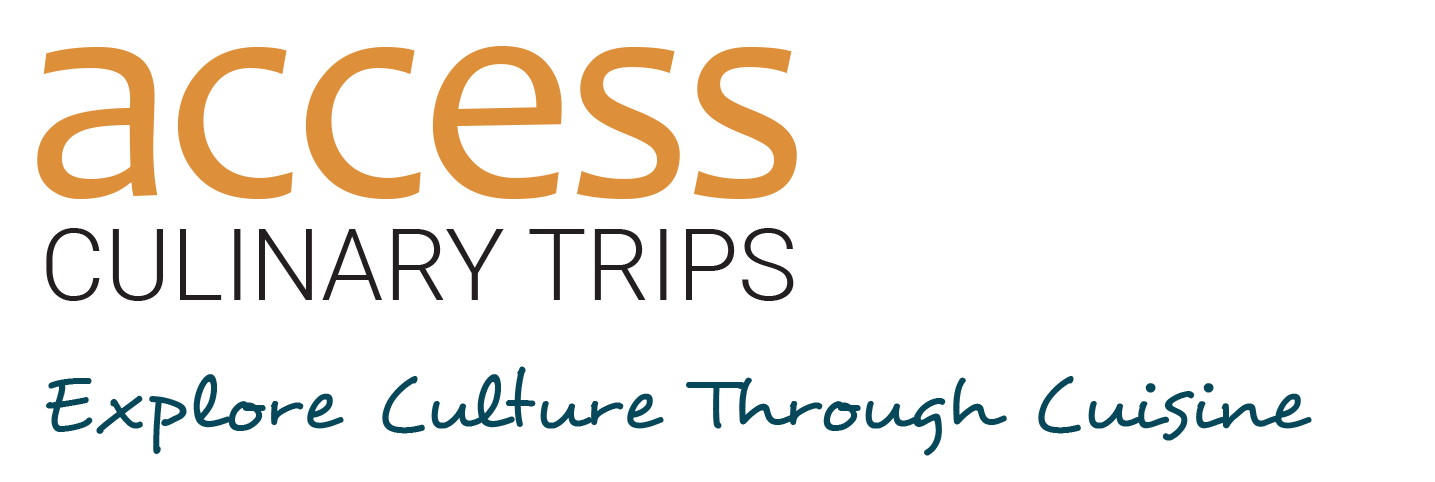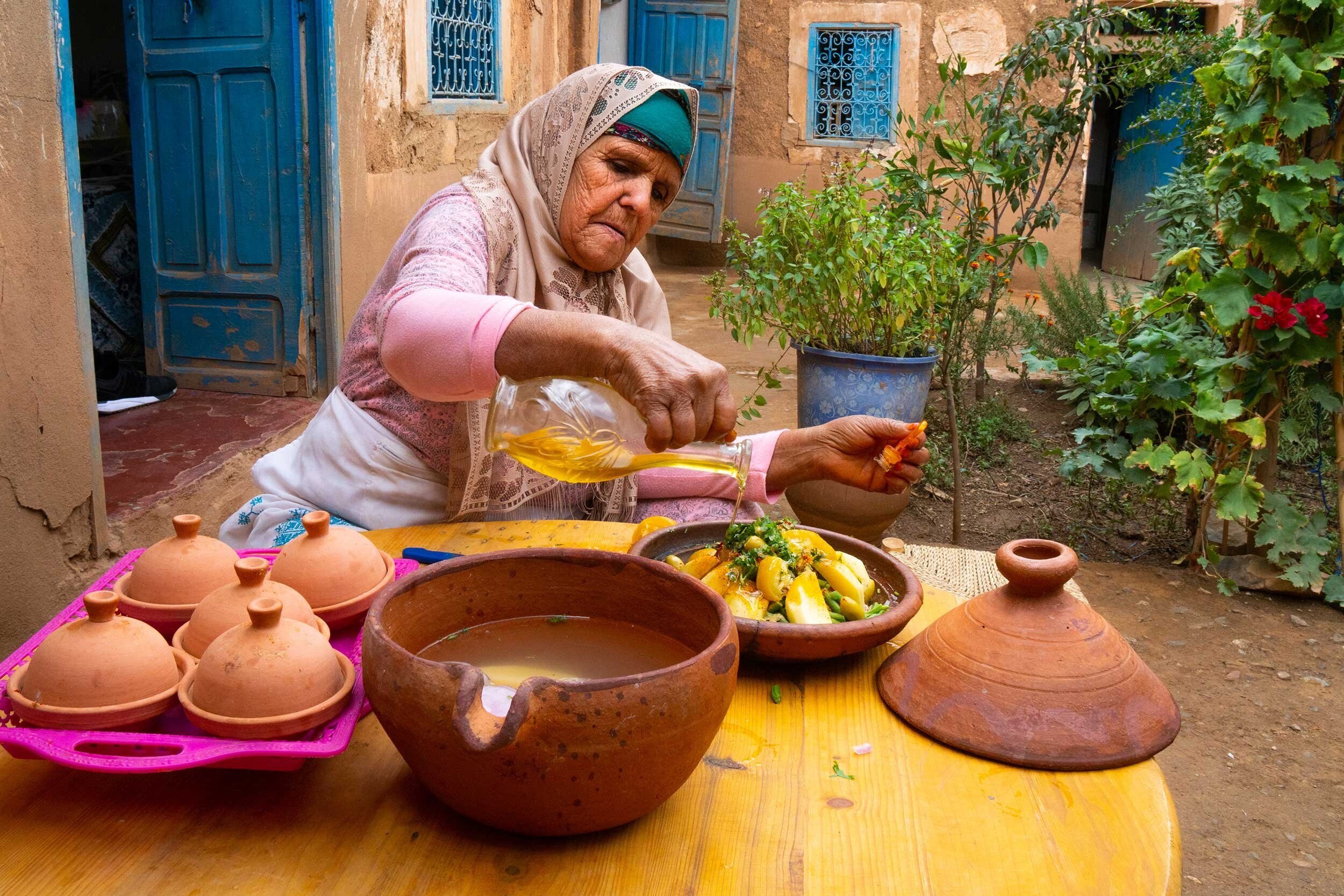Morocco’s Story Is Told Through Its Cuisine
Morocco sits at a crossroads of several civilizations, and ancient traditions are still part of everyday life. It’s seductive, as sweeping deserts contrast with more than 1,000 miles of coastline. Daily life in this predominantly Muslim country follows the rhythms of calls to prayer —but also the rhythms of the souks — the frenetic and near-mystical markets. Alleyways filled with fresh baked goods, produce, pungent aromas from colorful barrels of exotic spices, as well as tassel purses, leather slippers, silver lanterns, and jeweled caftans.
Morocco is a treat for the senses, particularly the taste buds. Arabic, Berber, French, and Italian influences merge to make Morocco one of the most fascinating and flavorful destinations in the world. From urban Casablanca to the fishing village Essaouira to Berber villages of the High Atlas Mountains to the mesmerizing Marrakech, Morocco’s distinct culture is a story best told through its cuisine, an exciting mix of Berber, Arabic, Andalusian, and Mediterranean cuisines with some European and sub-Saharan influences as well.
First were the Berbers, ancient migrant Libyans and Ethiopians. Over the centuries, Arabs, Phoenicians, Byzantines, Romans, Spaniards, Portuguese, Turks, Europeans and the French all arrived and left their mark. Most Moroccans today can claim both Berber and Arab ancestry, and there are villages in the Rif Mountains, High Atlas Mountains, and Souss Valley that still speak several ancient Berber languages.
Here are five must-try Moroccan specialties, and what they reveal about the history and culture of Morocco.
Moroccan Chicken-Almond Pastilla
An elaborate, savory meat pie generally served as a starter at the beginning of special meals. Preparing pastille is a labor of love, requiring many steps and ingredients, but when the chicken, almonds and array of spices come to together in the flaky crust. The classic version was brought from Andalusia. The name of the pie comes from the Spanish word pastilla, meaning in modern Spanish "small pastry" after the transformation of the phoneme "p" into "b" that is specific to the Arabic language. The pie combines sweet and salty flavors. Crisp layers of werga dough (a cousin of phyllo) encase savory meat —often chicken—slow-cooked in broth and spices including saffron and then shredded, and a crunchy layer of toasted and ground almonds, cinnamon, and sugar.
Prior to independence in 1956, the north of Morocco was controlled by the Spanish, and the south was controlled by the French. However the influence and the cultural connection remains. In the north of Morocco, in places like Tangier, people speak Spanish and listen to arabo-andalusian music, known as “al moussiqa al andaloussia.”
The Mediterranean lifestyle of the north of Morocco is influenced by Spain. The large avenues of the cities there accommodate the paseo, a Spanish habit of taking a walk in the evening. Spanish dishes like churros are still available in menus of the north. Even as far away as Marrakesh there has been an interest in bocadillos, a kind of Spanish sandwich. And while Morocco is known for its mint tea, you can find good coffee on the little squares in the Tangier medina.
Kebab Koutbane
Small cubes of beef fat are placed between the beef cubes of the skewer to compliment a spice-heavy Moorish marinade, adding additional flavor and juice to the meat. Beef is rarely grown or consumed, with lamb and poultry being the most often consumed sources of meat. Because of that kebab koutbane is a prestigious Moroccan dish that is prepared for special guests or in ceremonies such as “Eid Al Adha” because that’s when families slaughter a lamb or cow as a religious ritual, so there is enough meat to prepare kebabs. Red meat is expensive for many Moroccan families.
North Africa was once a major hub in the spice trade between Europe and Asia, which led to many Moroccans adopting a diverse set of spices into their cuisine. Some historians believe that the Moroccan ras el hanout mix came from the historical spice trade, as traders would sell blends cheaply as a way to quickly get rid of spices that were in oversupply.
The kebab was likely brought from the Middle East by invading Ottomans during the 16th century conquest. They were also responsible for local tastes for baklava and yogurt, and increasing the popularity of lamb.
Fish Tagine with Chermoula
Fish, yes, seafood! While we might think of great sandy stretches of dessert, Morocco has more than 1,000 miles of coastline that includes both the Atlantic Ocean and Mediterranean Sea. There is an abundance of fish in these coastal waters, with the sardine being commercially significant: Morocco is the world's largest exporter. At Moroccan fish markets one can find sole, swordfish, tuna, turbot, mackerel, shrimp, eel, skate, red snapper, crab, lobster and a variety of mollusks.
For fish cooked in a traditional Moroccan tagine, the chermoula marinade is the foundation. Packed with flavor, the chermoula is made with parsley, garlic, sweet paprika, hot paprika, cumin, turmeric, ground ginger, tomato paste, olive oil, and lemon juice. A mild white fish such as sea bass, makes the perfect focal point for this light Moroccan specialty.
The tagine may be the defining dish of Morocco.
A two-piece conical clay pot works similar to a slow-cooker to make a meat dish tender and to meld natural flavors of vegetables and spices. Its entrance in North Africa unmistakably came through the Berbers, the ethnically indigenous people of North Africa west of the Nile Valley and whose cultural history can be traced back 4000 years. They took advantage of the local abundance and combined olives, figs, and dates when preparing lamb and poultry, mixing everything in one pot for flavorful stews.
Aromatic and spicy-sweet-savory, tagines are made with many combinations: fish, lamb, or poultry, almonds, hard boiled eggs, lemons, potatoes, carrots, onions, tomatoes. Spices might include saffron, cumin, coriander, ginger, red pepper, cinnamon. Very often they call for fermented lemons—a practical preservation technique from the Jewish Moors—bringing a mildly tart and intensely lemony flavor to tagines.
Taktouka
Rethink your idea of salad. It’s hot and dry in Morocco, and lettuces and other delicate greens are cold-weather crops. Taktouka is a traditional Moroccan Arabian “salad” composed of tomatoes, peppers, onions, toasted paprika, parsley, and olive oil—cooked down into a stew and often served cold or at room temperature. In fact, Taktouka is actually a Berber word meaning vegetable stew. Cooked salads are a highlight of Moroccan cuisine – often served as sides and used for dipping.
Harira Soup
A Muslim staple to break the daily fast of Ramadan, this hearty soup has crossed over to the Moroccan Jewish tradition of breaking the fast of Yom Kippur. Whether served in small portions as a starter or with warm bread and a salad as a main course, it is created with a variety of ingredients—chickpeas, lentils, fava beans—with rice, vegetables, and an array of fresh spices. Often, it is made of lamb, beans, and fresh dates.
Moroccan Jews constitute an ancient community dating back over 2,500 years in the area, to the time of the Carthaginian state. Over the centuries, Morocco became a place for Jews from Spain to escape persecution. Before the founding of Israel in 1948, there were about 250,000 to 350,000 Jews in the country, which gave Morocco the largest Jewish community in the Muslim world. But today only 2,000 or so remain.
More information about Access Culinary Trip’s epic 9-day culinary trip to Morocco!

